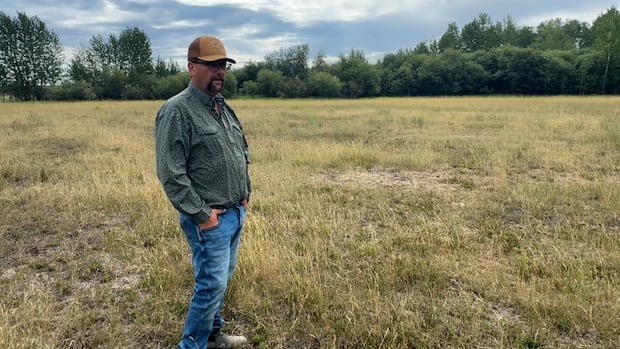Prolonged drought conditions in Alberta’s northwest has some cattle producers making tough decisions about the future of their livelihoods.
Seven regions declared agricultural disasters over the past few months, including the counties of Grande Prairie, MacKenzie, Saddle Hills and Northern Lights and the municipal districts of Greenview, Fairview and Smoky River.
“There’s been no growth of grass of any kind,” said Mark Jacklin, who owns Need More Land and Cattle Co., in Elmworth, Alta., near Grande Prairie.
Jacklin said over the past 10 years they would average about 1,400 bales of hay in a half section.
“This year we have 40 bales. It’s a hit.”
The hay crop on his land should have reached chest height, but it’s only a few inches tall this summer, Jacklin said.
Low soil moisture and a large infestation of grasshoppers is being blamed for this year’s agricultural disaster in the region.
For its part, the Agriculture Financial Services Corporation, a provincial crown corporation, adjusted the low-yield allowance for the 2025 crop year to try and help farmers salvage crops for livestock feed, reducing feed costs and increasing access to livestock feed in dry regions where it is scarce.
“There have been plenty of challenges thrown at our farmers and livestock producers over the past few years, and we know this one has been tough for many producers,” said Darby Crouch, a spokesperson for the agriculture ministry.
“The government is aware of several municipal declarations of agricultural disaster in Alberta and continues to monitor the situation.”
Cattle ranchers in northwestern Alberta are making some tough decisions. Years of drought are forcing some producers to sell off cattle — or even leave the business altogether.
Catherine Garrett is CBC’s video journalist in Grande Prairie.
Cattle prices, drought are both selling factors
Those in the cattle auction business have also noticed a difference in recent years.
Canfax, which reports on cattle market information, said year-to-date auction market volumes in northern Alberta are down about four per cent, but in June and July, auction volumes were up 23 per cent and and 31 per cent respectively from last year.
At his peak, Jacklin owned about 130 head of cattle, but he had to downsize to less than half of that because of lack of available feed.
“We already sold off a bunch of cow calf pairs in April. Then we sold some again in July,” Jacklin said.
The last of his cattle will go Oct. 1, he said.
“There won’t be any feed for them,” Jacklin said.
Producers are selling cattle earlier in the year than normal and raising smaller herds, according to auctioneer Mark Wall.
“Whatever they’re selling, they’re not buying back into it because they don’t have the feed, they don’t have the grass for it,” Wall said.
“With the drought, I’d say for almost every 10 guys that sell out of [the industry], you might see one or two new guys come back into it.”
Some producers are sending their cattle south to get fed, and others are buying out of the industry entirely, he said.
Short supply has also driven prices up significantly, which is another factor in why people are selling.
According to the Alberta economic dashboard, cattle prices for slaughter reached $292.91 in June 2025, a 15.3 percent increase from the same period last year.

“The guys that are pretty much close to retirement, why wouldn’t they liquidate when the prices are this high?” said Wall.
“They’re sick and tired of trying to find feed or buy feed or get feed hauled in. They figure if it’s going to be another dry year, why not? Why not just get rid of it and have no more stress?”
Hot, dry summers the new norm in northern Alberta
Alberta farms totalled 4.7 million head of cattle and calves this year, according to statistics from the province.
That represents just over 40 per cent of the national total.
But that number is down 0.9 per cent from the previous year and marks the third annual decline in a row.
“Producers in the Peace River area are competing for feed from areas that are a little bit closer and they’re having to pay a lot of extra money, ” said Trevor Hadwen, an agroclimate specialist at Agriculture and Agri-Food Canada.
“That becomes unsustainable when you’re starting to bring in feed for such a long period.”
He said much of the Peace region is now considered under extreme drought conditions and little to no relief is expected in the upcoming forecast.
“Producers are usually well equipped to handle one or two years of drought. They save over some feed. They have some plans in stock for areas that might be able to be grazed in a year that’s dry,” said Hadwen.
“But once you’re starting to get into multiple years of drought, those options go away.”
Jacklin knows that feeling first hand.
“We’re selling animals that we wouldn’t normally sell, like our breeding stock. We wouldn’t sell them,” said Jacklin.
“But we have no choice, because we can’t feed them.”






